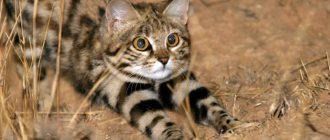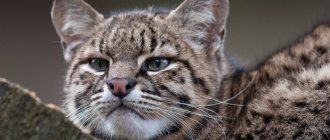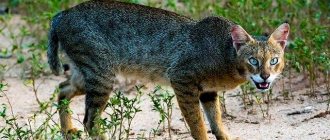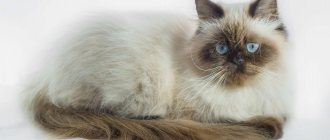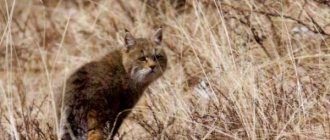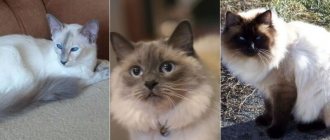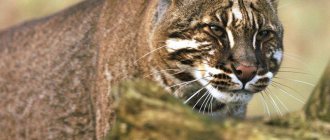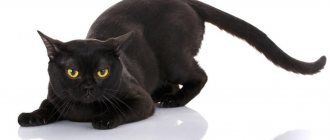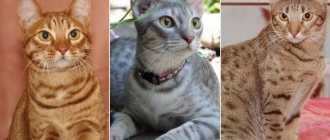Appearance characteristics
Solidity and impressiveness - these epithets perfectly describe the appearance of a nimble cat, which, it seems, will resemble a cute and fluffy kitten until old age. The Pampas cat breed has the following external features:
- The head is round in shape, massive and wide with a convex and expressive forehead.
- The nose is large in size, due to which it stands out well on the muzzle.
- The ears are triangular, high placed. A contrasting line runs along the edge of the fur of the ears.
- The eyes are of medium diameter, the pupils are located vertically.
- The body is up to 75 cm long, the weight of an adult is from 3 to 6 kg, males are heavier than females.
- The paws are muscular and quite short (when compared with other feline representatives), the feet are wide, and the claws are retractable.
- The tail is about 25 cm long.
- Wool – very dense, the length of the fibers is 7 cm. Depending on the habitat, the wool can have a different color.
Most representatives of the breed are gray in color with a brownish tint. In addition, there are individuals with a red tint to their fur; there are also Pampas cats whose fur has a rich black color, but this is most likely an exception to the rule.
The animal's muzzle is very cute, its mouth has a peculiar shape that resembles a smile. But such cuteness is very deceptive - the animal cannot stand communicating with strangers, showing with all its appearance that it will behave aggressively if its privacy is interfered with.
Security status
Pampas cats are listed on Appendix II of the Convention on International Trade in Endangered Species (CITES), meaning that trade in this species must now be strictly controlled. Hunting Pampas cats is strictly prohibited in Argentina, Bolivia, Chile and Paraguay, and regulated in Peru, but legislation does not protect these animals in Brazil and Ecuador. Conservation activities include identifying species and conducting research into the behavior, ecology, and distribution of animals.
Features of life in the wild and hunting
Representatives of the Pampas breed are distinguished by excellent auditory and visual characteristics.
Their vision reaches its maximum sharpness during the period of pitch darkness, when the animals go hunting. The cat is dexterous and flexible; it has no difficulty for her to climb the sloping branches of tall trees.
For shelter and rest, cats choose crevices in rocks, between tree roots rising above the ground, and also feel comfortable in bushes with high branches and lush leaves. Each individual has its own territory, which averages about 30 km2. The cat marks the occupied territory, irrigating the grass with drops of urine.
If a Pampas cat feels danger and a threat to its life, its fur begins to stand on end, the animal turns into a solid “ball” of hair. The cat prefers not to enter into open confrontation with enemies, so in moments of greatest danger he sits out on a tall tree. If there are no high branches nearby, the cat is saved by the fact that it can run fast.
The animal hunts at any time of the day, but still prefers the night. Thanks to the excellent functioning of the visual organs, the cat easily tracks the victim by tracks and scent. The furry hunter overtakes the chosen victim with several large jumps, a couple of meters long. Unlike most cats, the Pampas breed does not waste time sitting on the victim for a long time, preferring to overtake it and knock it down, while latching its teeth into the neck.
If you watch a cat for a long time, you get the impression that it is clumsy and short-legged, and cannot seem to be an excellent hunter. But this particular breed is considered the best hunter among other medium-sized cats. The animal attacks its target so quickly and swiftly that it does not have time to understand anything.
Who is in the “enemy” camp
In the wild, the Pampas cat is afraid only of large birds, predators larger than itself, and humans. This predator has always been the target of poachers. This is due to the thick and beautiful fur of the animal, from which fur coats were made. Due to the fact that the breed was hunted for a long time, the species at one point was on the verge of complete extinction, the population size decreased so much.
Today the population of the Pampas breed numbers about 50,000 individuals. These data are highly generalized, since the animal leads a secretive lifestyle, which makes it difficult to observe it for a long time.
In 1987, it was prohibited by law to hunt Pampas cats for the purpose of extracting fur and selling it to private owners.
This law took effect, and the breed population was partially restored.
Behavior and lifestyle
The Pampas cat is a nocturnal animal that sees well and navigates in the dark. But sometimes the animals go out for a walk or hunt in the daytime. These animals lead a solitary life. Each cat has its own territory that it controls. Typically, property boundaries extend for 30 and sometimes 50 km. These cats, like domestic cats, flee from danger. And at the first opportunity they climb the tree. If there is nowhere to run or the animal encounters an opponent, it raises its fur on end to visually increase in size and scare away the enemy. These cats are often aggressive towards humans, so they are difficult to tame. In captivity they can live up to 12 years.
Nutrition
The diet of the Pampas cat consists of small rodents and small birds. If the hunt for rodents was unsuccessful, or the cat wanted to treat itself to a new menu, then they do not hesitate to feast on insects and non-poisonous reptiles.
The Pampas breed is quite neutral towards people with whom it often lives close. But people don’t like being around furry predators. The reason for this is that the cat preys on poultry, often destroying farmland.
Find out what other breeds of wild cats exist:
- black-footed cat;
- manul;
- dune cat
History of the discovery of the Pampas cat species and subspecies
These unusual wild cats were discovered in Chile back in the 18th century. The Spanish explorer Julian Ignesias Molin proposed the name Felis Colocolo for these animals in 1782.
Only subsequent later studies revealed differences in the structure of the skull, color color and fur structure of many of the discovered individuals. It was the Pampas cat that was described in 1816, and the Pantanal cat (Leopardus braccatus) in 1889.
In 2005, it was decided to divide Chilean cats into three separate species, with subspecies:
- Leopardus colocolo or Bell. It lives in the north of Chile in the mountains and in the center in sutropical forests on the western slopes of the Andes. The wolffsohni subspecies (and there are only two of them: this one and colocolo) has the same coloring and pattern as some Pampas cats, which is why there is confusion not only in the names, but also in the definition of species.
Leopardus colocolo wolffsohni
Leopardus colocolo colocolo
- Leopardus braccatus or Pantanal cat. Habitat: Paraguay, Uruguay, extreme east of Bolivia, southwest of Brazil, extreme northeast of Argentina. Previously it was considered a subspecies of L. colocolo, but the color, pattern and even size of the skull are very different. Those who advocate genetics still consider the cat to be a subspecies, but most scientists disagree. It has two subspecies: L. b. braccatus and L. b. munoai.
- Leopardus pajeros or Pampas cat;
The Pampas cat has 5 subspecies:
- L.p. pajeros (Desmarest, 1816). They live in the center and south of Argentina, as well as in Chilean Patagonia. The pattern can be of two types, as shown in the photo below. Sometimes this subspecies is divided into two more: L. p. pajeros northern and L. p. crucinus southern (larger). In crucinus, the color can only be of the second type, it has a grayish tone, while in pajeros there can be both patterns and the color itself is more red.
- Let's look at the two subspecies together: L. p. garleppi (Matschie, 1912), which are found in Peru and L. p. thomasi (Lönnberg, 1913), which live in Ecuador. They have a similar coloration, which you see in the photo below, as well as the structure of the skull. Both subspecies live in the steppe highlands, and they are separated not only by their habitat, but also by quite significant differences in size; thomasi is much smaller than garleppi.
- L.p. budini (Pocock, 1941). Lives in Argentina. There are two types of wool pattern, as shown in the photo below.
- L.p. steinbachi (Pocock, 1941). Habitat Bolivia. The skull is larger than that of the nearby garleppi from Peru, and the rosettes are paler. It is difficult to say whether there is justification for identifying this subspecies; there is too little information, but sometimes they talk about it.
Photo gallery of Leopardus braccatus or Pantanal cat, which is often considered a subspecies of the Pampas cat, which is incorrect:
Continuation of the family line
Pampas cats are typical solitary cats of the wild. They live exclusively solitary lives; females and males unite only during the mating period. After mating, the male leaves the female, and they no longer see each other. All care for the offspring is entrusted to the female, who first feeds the cubs with milk, and then begins to accustom them to food of animal origin and teach them hunting skills.
Pregnancy lasts for a long time, about 3 months. Kittens in a litter are large in size, which is why only 1-2 of them are born. In extremely rare cases, a litter consists of 3 kittens. Kittens need the constant presence of their mother until they are 6 months old.
Puberty and reproduction
Very little is known about the reproduction of Pampas cats in natural conditions due to the high secrecy of these representatives of the cat family. For the most part, scientists have made some conclusions only by observing a few animals living in captivity.
In zoos, the mating season for Grass cats occurs in April-July. At this time, males are very active, they have constant battles in the struggle to mate females.
Pregnancy lasts quite a long time, from 75 to 85 days. It ends with the birth of a litter, in which there are from one to four kittens, but usually there are two or three.
Babies weigh 100-130 grams and suckle their mother for up to 3-4 months. After 10-14 days, their eyes open, and from the second they begin to actively move, crawl out of the den and play. At two, they are fed with the meat that their mother gets for them; at four, the female begins to teach them hunting skills. At six months the animals become completely independent and are able to live alone.
Puberty occurs towards the end of the second year of life.
There are known cases of Pampas cats living in captivity for up to sixteen years; in their natural habitat, life expectancy is apparently much shorter.
Features of living in captivity
Pampas cats are outwardly quite cute and fluffy animals, so because of this appearance, one gets the misleading impression that they are very kind and affectionate. It is almost impossible to tame this wild hunter as a pet. However, some lovers of exotic breeds want to get a Pampas cat without fully realizing what awaits them.
Life in captivity, whether in a zoo, nursery, or private property, is accompanied by a difficult period of acclimatization for the animal. Being taken out of natural conditions, the animal experiences severe stress, which negatively affects its immune system and health.
At first, a cat that ends up in a zoo, even though all conditions will be created for it, behaves with increased aggression and is constantly nervous.
In captivity, an animal does not produce offspring, and if an adult individual has been deprived of its natural habitat, it will not be possible to change its behavior and accustom it to life in new conditions.
If you want to get a Pampas cat, you need to equip a large enclosure for him outside. Representatives of this breed are completely unsuitable for living in an apartment, only in a private house with a large local area. Food – fresh, lean meat, fish. Industrial feeds are excluded from the animal’s diet.
If you decide to have this breed of cat as a pet, you should understand that you won’t be able to play with it. An animal, no matter how comfortable living conditions are created for it, will never abandon its wild habits and will not make contact with humans, remaining only a furry resident of an enclosure with an unkind and nervous character.
Pampas cats who were forced into captive conditions at a tender age adapt more easily. But as they grow older, their natural instincts and savage character will manifest themselves more and more.
Mr. Cat recommends: description, characteristics, habitat of the Pampas cat
Leopardus pajeros is a small predatory feline that lives mostly in grassy plains found in Latin America. If we talk specifically about the Pampas cat, it lives in Ecuador, Peru, Bolivia, Argentina and Chilean Patagonia. If we speak in a broad sense and include L. pajeros, as L. colocolo and L. braccatus are often done, then Brazil, Paraguay, Uruguay, and Chile should be added to the range.
The classification of the Pampas cat is still not clear. Her story is very confusing. Repeatedly its types were divided and united again, which is why we actually talked about it now in a narrow and broad sense. Sometimes the Pampas cat is written about as colocolo (Bell), in particular on Wikipedia, sometimes three species are meant by it: colocolo (Bell), braccatus (Pantanal cat) and pajeros itself.
The second name of the beast is Grass Cat. Although occasionally the animal is found in bushes, woodlands, semi-deserts of Patagonia and in the Brazilian pantanal, located in the area of a swampy tectonic depression.
In 2021, the Pampas cat was temporarily recorded in the Sechura Desert and dry forest in northwestern Peru.
This predatory mammal has been studied very little, despite the fact that the species was discovered more than two centuries ago. The Pampas cat is a very secretive animal, trying not to show itself to anyone.
The animal has a small and dense body with short limbs and a massive head and steep forehead.
Powerful paws have wide pads and claws that retract completely into them.
The nose is wide and long, protruding strongly beyond the cheekbones. The wild large lobe is usually pinkish in color and may have a dark edge.
Small triangular ears are set high and trimmed with black fur.
The eyes are small but expressive, the pupil is vertical.
The fur is coarse and shaggy (up to 7-8 cm long) of grayish-yellowish shades; marks of brownish or straw tones are scattered across the main background. Along the spine, the fur puffs up even more, forming a kind of mane.
The tail is long and bushy with reddish ring lines.
The total length of the body is about 80 cm, the tail is 20-30 cm, the weight of the feline representative is from 7 to 12 kg. That is, the Grass Cat is only slightly larger than the average pet, with thicker fur on its tail. Shaggy fur outwardly increases the size of the animal, and it seems clumsy.
There are six color variants of Leopardus pajeros, but all animals have two longitudinal dark lines on the cheekbones:
- The main background is reddish or deep gray, the spots are rusty-brown on the sides, the upper part of the ears is darker and ends with black tips. There are four or five red ring markings on the tail. The stripes on the paws are dark brown, there are charcoal markings on the chest, and the abdominal area is whitish. It lives in central Chile, in subtropical xerophytic forests at an altitude of 1800 m above sea level.
- The northern Andes are home to Pampass cats with reddish-brown rosette-shaped spots with darker borders, numerous rings on the tail (the same color as the side spots) and very dark brown, almost black stripes on the legs with spots or stripes on the undersides. body parts.
- The next isomorph resembles the previous type, but the background color is paler, and the body markings, stripes on the hind legs and rings on the tail are paler and less distinct.
- Another color morph resembles the previous two types, but the background is overall grayish with distinct dark brown stripes on the legs and spots on the underparts, a straight tail (no distinct rings), and mostly indistinct dark lines on the sides.
- The next variety is almost entirely rusty brown with faint spots, solid stripes, a loose tail with a prominent black tip, and completely black legs.
- This subtype is similar to the previous one, but the background color is paler and more yellowish, with the side spots being browner and more distinct, the feet (only black on the soles), broken rings, and a narrow black tip on the tail.
Pampas cat
A small predator lives and hunts in the pampas, hiding among the tall grass from the heat of the day, but some subspecies are found in the Andes and at an altitude of about five thousand meters.
The high secrecy of the animal does not allow us to collect accurate knowledge about the current population, but, most likely, the number of Pampas cats is not under threat and numbers at least fifty thousand specimens. Nevertheless, at the end of the last century, the world community introduced restrictions on the hunting of these animals, since Leopardus pajeros is still being displaced by humans from its natural habitat, the food supply is declining and poachers are hunting.
What does it eat?
The cat feeds on small rodents, lizards, birds, eggs and even large insects. Sometimes, if there are populated areas nearby, animals can drag the chicken away. The border of the Kolokolo property reaches from 30 to 50 kilometers.
Pampas cats live mainly on the ground among grass and small rocks, but sometimes, if there is a threat to their lives, they can jump onto a tree.
Description of the breed
In nature, there are seven subspecies of this animal. They differ only in color and size.
The cat itself is not big. The body length of the animal is about 76 centimeters including the tail. The tail itself reaches 25 centimeters. Legs are short. Height at the withers is only 30 centimeters. Pampas cats weigh from 6 to 15 kg. But large specimens are rare. Most often cats weigh 9-10 kg.
The cat's body is dense, its legs are short, and its head is large. The coat is thick, long, yellowish-gray in color with brown or straw-yellow elongated spots - the color of scorched grass. Along the ridge the hair stands like a boar's mane, and on the fluffy tail there are red-brown rings.
The color of the fur coat is very diverse. It can be either monochromatic - variegated gray or yellow, or beautiful red-brown oval spots. It all depends on where the cat lives. When meeting an enemy, the fur stands on end to intimidate.
The head is large and wide with large pointed ears. There are dark stripes on the cheeks. The eyes are not large and yellow-brown in color. The nose is convex and shaped like a ferret, brownish-red in color with a dark rim. Because of this nose, the grass cat cannot be confused with anyone else. Otherwise, bell cats are very similar to domestic cats.
